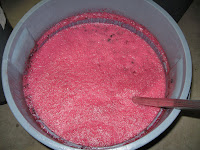After about 10 days, the musts were ready to press. I had added malolactic bacteria when the brix reached about 1.5-2 to try to take advantage of the residual warmth to help the bacteria get established and growing.
Took Friday, 11/5 off of work after a rather tumoltuous week of nearly losing my job during a surprise round of layoffs. After that scare and utter depression at losing both of my direct reports, I really needed a day to dive into wine and get my mind back into shape.
I don't know about my mind, but my body apparently wasn't quite up to the challenge.
It was a bit of work to press off the wine from the grapeskins and then transfer the buckets of wine down to the basement to pour into the stainless steel tanks. I really need to get a better system for this transfer instead of getting that much oxygen exposure. Future plans...
Here's the basic story in pictures for the cab franc:




Not quite sure how much merlot wine I ended up with--probably at least 40 g. Got a good 24 gallons of cabernet franc and 27 gallons of lemberger. Similar yield (~26 gallons) for the zinfandel. But the stuff has to sit there for a couple of days so I can rack off the gross lees, so I'll lose 1-2 gallons based on how fluffy the lees layer is.
My arms and back gave out around midnight when I was lugging the last few carboys down to the basement (merlot and cab franc in SS tanks, the zin and lemberger are in carboys). Guess all that weight lifting I had been doing in the preceding weeks only went so far! I was incredibly sore for about 3 days after that!
That's where things are sitting at the moment. Will rack off the gross lees this upcoming weekend, but this is where the wine will be for the winter. It's a little too cold for malolactic fermentation to really go strongly and it's just going to get colder. Fortunately, when the cellar is about 40 °F, I don't have to worry about bad microbes infecting the wine while I don't have it treated with sulfite. Things will be pretty much good until spring.
Cheers,
Noel







